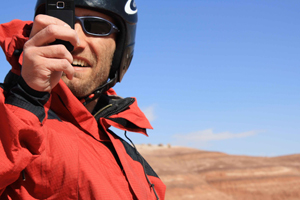Eye robot
Chicago geophysical scientist Patrick McGuire develops artificial-intelligence technology to turn astronauts into “cyborg astrobiologists.”
By Jason Kelly
Photography by Lorenz Wendt, Christoph Gross, and Bernard Foing

Christoph Gross, a German researcher on Patrick McGuire’s team, gathers images of geological formations at the Mars Desert Research Station in Utah. A computer processes the images in real time and sends the results back to the phone. One day astronauts could use the technology to search for life on other planets. View the slide show.
Patrick McGuire, AB’89, shares the grand vision for his research that has captured the scientific community’s attention. Wired and other publications have seized on his long-term idea of astronauts, equipped with his wearable computer, studying other planets. The system would transform the astronauts into super-geologists capable of identifying details—lichens, iron deposits—that might be too small to see or too obscure to recognize without specialized training. In effect, the artificial intelligence could help humans look for life on Mars.
A geophysical research scientist at Chicago, McGuire has dubbed this futuristic concept the “cyborg astrobiologist,” which sounds like sci-fi come true. “The human would supply the mobility and the overall babysitting,” he says, “and the computer would serve as the blank slate” to gather and analyze information the astronaut might miss.
That application of the research is exciting to ponder but “a little bit grandiose,” McGuire admits, and probably at least several decades from fruition. Applying this technology to space-exploring robots, on the other hand, could happen in the foreseeable future, perhaps within ten years.
McGuire programs computers to identify novel elements in photographs or microscopic images of geological formations. His International Journal of Astrobiology article, published online November 30, showed the novelty-detection system identifying lichens and red mudstones on outcrops in Spain and at Utah’s Mars Desert Research Station. McGuire’s team of ten researchers, based mostly in Europe, developed a concept called interest maps, essentially a sophisticated way for a computer to study the microscopic or photographic images as a child does, pointing out what piques its curiosity.
The system analyzes images based on color, highlighting what it hasn’t seen before. That process has proved reliable and encouraged McGuire to pursue more complex programming that he hopes will teach the computer to see in more detail. He’s working to add texture to the computer-vision’s capabilities.
McGuire envisioned that capability when he started the project in 2002, but programming the system to identify different textures became too time consuming. Following a colleague’s suggestion to use information theory and image compression, he has resumed the effort. “Maybe there’s a way to simplify the texture problem,” he says, “but I haven’t found it yet.”
During the painstaking work, McGuire allows himself the occasional glimpse at its long-term potential—combining human geological expertise with a computer’s novelty-detecting vision to put cyborg astrobiologists in space. As he emphasizes, that’s the secondary end. The main goal is to develop reliable scientific-autonomy systems and “transplant the brains of the computers into robots that will go to the moon, go to Mars, and explore,” which still sounds pretty grand.
WRITE THE EDITOR
DISCUSS THIS ARTICLE
E-MAIL THIS ARTICLE
SHARE THIS ARTICLE
WEB EXTRA
- "AI Spacesuits Turn Astronauts
Into Cyborg Biologists"
(Wired, November 2, 2009)
- "Phonecams Could Boost Hunt
for Mars Life"
(New Scientist, June 2, 2009)
- "‘Cyborg Astronauts’ Could Scan
for Life on Mars"
(Chicago Maroon, November 13, 2009)
- "The Cyborg Astrobiologist"
(International Journal of Astrobiology, 2010)
